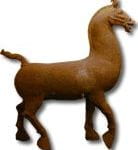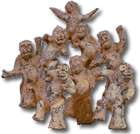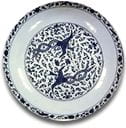Earthenware, stoneware, porcelain: what’s the difference?
Earthenware
There have been ceramics almost as long as there have been human cultures—people have always needed vessels to cook and store food and liquids.

The first ceramics archaeologists have found date back more than 10,000 years. These were earthenware, which means they were made from clay and fired at the kind of low temperatures reached by a wood fire or simple oven, between 1202°F (650° C) and 1832°F (1000°). This is still pretty hot when you think how hot your oven at home gets, which is probably about 450°F (230° C) or 500° F (260° C).
Most earthenware vessels, such as terra cotta flowerpots that you may have at home, are not waterproof. They can be polished (or burnished) to close the pores after firing or covered with glaze and fired again.
In China, most ceramics made before the Tang dynasty are earthenware. They may be unglazed and painted or they may be glazed. Their glazes contain lead and are often brightly colored.
The Han horse above is unglazed earthenware. The acrobats to the right are painted earthenware.

Stoneware
Stoneware ceramics are harder and less porous than earthenware and are fired at hotter temperatures—between 2102°F (1150°C) and 2372°F (1300°C). At these high temperatures, the surface of the clay melts and becomes glassy.

Although stoneware is usually waterproof, most stoneware ceramics are glazed for decoration. The glazes often contain ash, which allows the glaze to harden at stoneware temperatures.
The bowls to the right are glazed stoneware.
Porcelain
Porcelain was first made in China in the 6th and 7th centuries AD from porcelain clay (known as kaolin, after the Gaoling Mountains of southeastern China). Chinese potters mixed the kaolin clay with a powder ground from a stone called baidunzi, a rock that contains feldspar, a glassy mineral. It is fired at very high temperatures above 2372°F(1300°C), which causes the surface of the clay to melt and become smooth as glass.

Early porcelains were undecorated and were used by the Imperial court and exported as far as the Middle East. Blue and white porcelain is painted with blue paint made from cobalt and then covered with a clear glaze, which can withstand the high temperatures of the kiln. Other kinds of porcelain are painted after the object has been fired in the kiln.

The word “porcelain” comes from an Italian word porcellana or “little female pig,” the Italian name for small white cowrie shells. The first Italian travelers to China saw beautiful Chinese porcelains and thought that these ceramics were made from ground-up sea shells. The name has remained, however, even though they are not made from shells.
This plate is an example of blue and white porcelain.